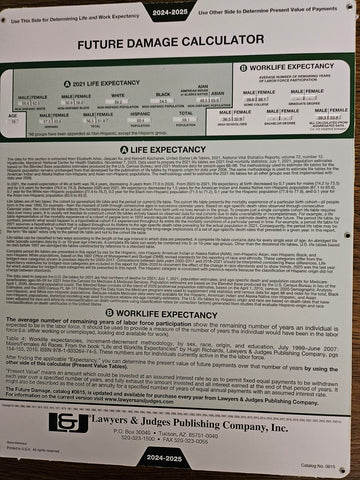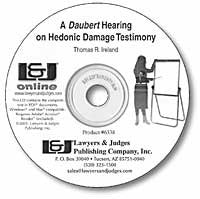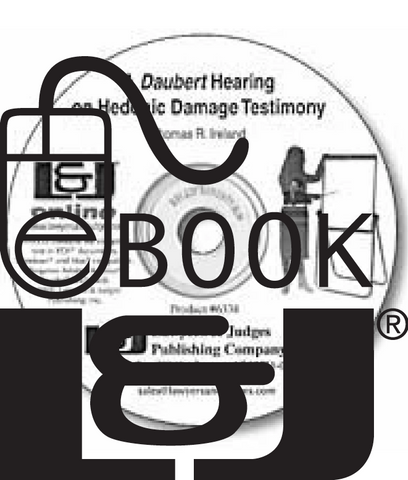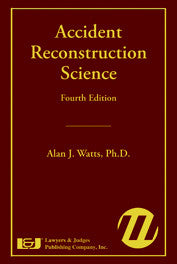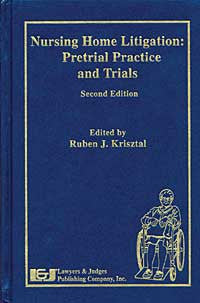
Nursing Home Litigation: Pretrial Practice and Trials, Second Edition
- Editors: Ruben J. Krisztal, Patricia W. Iyer Contributors: Patricia W. Iyer, Jeffrey M. Levine, Stephen Appelbaum, Julie A. Braun, David H. Brinton, Elizabeth A. Capezuti, Libby E. Edwards, Desmond Fuller, T. Patrick Ford, Jr., Benjamin W. Glass, III, Sanford I. Horowitz, M. Elizabeth Lanier, William T. Lawson, III, J. Roslyn Lemmon, Steven M. Levin, Pamela J. Lormand, Janet S. McKee, J. Scott Myers, John M. Parisi, John Patrick Petrullo, Roger Rider, Briana Rivera, Thomas Rockwell, Beth N. Rom-Rymer, Gerald B. Taylor, Gregory A. Witke, Sunny Kim, John M. Parisi
- ISBN 13: 978-1-930056-48-0
- Copyright Date Ed: October 3, 2003
- Pages: 627
- Binding Information: casebound
- Size: 6 X 9 Inches (US)
A must-have reference for any professional involved in nursing home cases.
The litigation of neglect and abuse of the elderly in assisted living and nursing home facilities is unlike any other personal injury litigation. The second edition of Nursing Home Litigation: Pretrial Practice and Trials has been significantly expanded and will provide you with a detailed step-by-step look at how nursing home cases should be handled.
The book's chapters are organized in a way that will help you with your case from pretrial to trial. The first chapter will give you tips and techniques for writing the demand letter. The following chapters provide insight for both the plaintiff's attorney and defense attorney on topics such as interviewing older witnesses, preparing staff for deposition, demonstrative evidence, voir dire, opening and closing arguments.
Also included is a FREE CD-ROM of actual depositions of nurses, administrators, directors of nursing and upper management in nursing homes.
This book is also available as an E-book. Click here to purchase and download:
New topics include
- Handling older witnesses: the defense perspective
- Preparing nursing home staff for deposition
- The preparation and use of demonstrative evidence
- Fighting fraud in long-term care
- Voir dire, opening arguments and closing arguments
- Punitive damages
- The role of nutrition
- The Medicare "super lein"
- CD-ROM of actual depositions of nurses, administrators, directors of nursing and upper management in nursing homes
Table of Contents
Foreword
Preface
1. The Demand Letter
Ruben J. Krisztal, Esq.
1.1 Introduction
1.2 Notice of Intent to File Suit
1.3 Demand Letter
A. Decubitus ulcer case
B. Falls--Fractured hip and subdural hematoma
C. Sexual abuse
D. Improper use of medication--NSAIDs
1.4 Conclusion
Endnotes
2. Dealing with the Older Witness: The Plaintiff's Perspective
Julie A. Braun, J.D., LL.M.
2.1 Introduction
2.2 Interviewing the Older Witness
A. Law office accessibility and environment
B. Establish rapport
C. Collect data
2.3 Motion Practice
2.4 Pretrial Conference
2.5 Preparing the Older Witness
A. Extent and methods
B. Tell the witness what to expect
C. Tell the witness what to wear
D. Tell the witness how to get there
E. Tell the witness about physical barriers at the courthouse
F. Tell the witness to bring visual and hearing aids
G. Dress rehearsal
2.6 Trial Techniques and Tips from the Trenches
A. Addressing the older witness
B. Introducing the older witness to the judge and jury
C. Physical effects of aging
D. Direct examination of the older witness
E. Cross-examination of the older witness
2.7 Educating the Judge and Jury
A. Overcoming perceptions about impairments
B. Refuting stereotyping and ageism
C. Awarding damages
2.8 Conclusion
Endnotes
3. Dealing with the Older Witness: The Defense Perspective
Thomas Rockwell
3.1 Introduction
3.2 Why Use an Older Witness?
3.3 Interviewing the Older Witness
3.4 Deposing the Older Witness
3.5 The Older Witness at Trial
3.6 Conclusion
4. Handling Witnesses: Deposing Family Members
J. Roslyn Lemmon and Pamela J. Lormand
4.1 Introduction
4.2 Initial Investigation--Preparations for Deposing Family Members
A. Identification of issues and analysis of the nursing facility chart
B. Identification and interviewing of essential nursing facility staff
4.3 Deposing Family Members
A. Understand what motivates family members to file suit
B. Explore the family members' relationship with the resident
C. Discuss the reason for nursing home placement and the decision to choose a particular nursing facility
D. Establishing the resident's physical and mental conditions
E. Exploring family members complaints
F. Investigate the relationship the family member had with the nursing staff
4.4 Conclusion
Endnotes
5. Handling Witnesses: Deposing the Medical Director, Director of Nursing, Attending Physician, Nursing Home Administrator and Upper Management
Gerald B. Taylor, Jr., Esq.
5.1 Introduction
5.2 General Questions
A. Resident's rights
B. Resident behavior and facility practices
C. Quality of life
D. Resident assessments
E. Quality of care
F. Nursing services
G. Dietary services
H. Dental services
I. Pharmacy services
J. Administration
5.3 Medical Director
A. Duties and responsibilities
B. Sample questions
5.4 Director of Nursing
A. Duties and responsibilities
B. Sample questions
5.5 Attending Physician
A. Duties and responsibilities
B. Sample questions
5.6 Administrator
A. Duties and responsibilities
B. Sample questions
5.7 Upper Management
A. Duties and responsibilities
B. Sample questions
5.8 Conclusion
6. Handling Witnesses: Working with Expert Witnesses
William T. Lawson III, Esq. and Elizabeth Capezuti, Ph.D., R.N., F.A.A.N.
6.1 The Expert Witness
A. Selecting the expert
B. Contacting the expert
C. Preparing your case for submission to the expert
D. The expert's report
E. Preparing your expert for trial
F. Direct examination of your expert
6.2 Dealing with the Opposing Expert
A. Evaluate the expert's credentials
B. The opposing expert's report
C. Consultation with your expert
D. Anticipate opposition testimony
E. Plan and limit your cross-examination
6.3 Conclusion
References
7. Presenting Defense Witnesses for Deposition
J. Scott Myers, Esq.
7.1 Introduction
7.2 Visiting the Facility
7.3 Meeting the Administrator and Staff
7.4 Obtaining the Nursing Home Chart
7.5 Determining Which Individuals Need to Be Deposed
7.6 Presenting the Witnesses
A. The administrator
B. The director of nursing
C. The assistant director of nursing
D. The charge nurse
E. Other nurses
F. Certified nursing assistants (CNAs)
G. Former employees
7.7 Conclusion
8. Preparing Nursing Home Staff for Deposition
J. Roslyn Lemmon and M. Elizabeth Lanier
8.1 Introduction
8.2 Basic List of Nursing Home Staff Members
8.3 Initial Meeting
8.4 Follow-up Meetings
8.5 General Deposition Preparation
8.6 Specific Deposition Preparation
A. Administrator
B. Director of nursing
C. Staff (charge nurses)
D. Certified nursing assistants (CNAs)
8.7 Conclusion
Endnotes
9. The Preparation and Use of Demonstrative Evidence in Nursing Home Cases
Stephen Appelbaum, C.E.P., E.P.I.C., Patricia Iyer, M.S.N., R.N., L.N.C.C. and John M. Parisi, Esq.
9.1 What is Demonstrative Evidence?
9.2 The Courtroom as a Classroom
9.3 Right-Brain/Left-Brain Learning
9.4 Preservation and Presentation
A. Photography
B. Videotape
C. Scene diagrams
D. Radiology and diagnostics
E. Nursing notes and treatment records
9.5 Liability Exhibits
9.6 Timelines
A. Use of timelines
vB. Design principles
9.7 Anatomical Models
9.8 Medical Illustrations
A. Sources of illustrations
B. Custom illustrations
9.9 Instructional Videotapes
9.10 Medical Equipment
9.11 Computer Animations
9.12 Considerations in Selecting an Approach to Presenting Demonstrative Evidence
A. Planning
B. Budget
C. Effect
D. Comfort level
9.13 Overview of Presentation Systems
A. Paper system
B. Optical projector-and-screen systems
C. Electronic projectors
D. Digital system
9.14 Design Principles of Presentation Software
A. Readability
B. Comprehension
9.15 Chart Design
A. Types of charts and design principles
B. Mistakes to avoid
9.16 Evidentiary Considerations
A. Relevance
B. Materiality
C. Unfair prejudice
D. Hearsay
E. Exceptions to hearsay
9.17 Types of Trial Exhibits
9.18 Basic Considerations for Use of Exhibits at Trial
9.19 Authentication of Exhibits
9.20 Conclusion
Reference
Additional Readings
10. Discovery Motions
Briana Rivera, Esq.
10.1 Introduction
10.2 Procedural Strategies to Increase Your Chances of Success in Discovery Motions
A. The complaint
B. Understanding and identifying the information and documents you are seeking
10.3 Overcoming Common Objections to Discovery
A. Peer review and quality assurance
B. Third-party confidentiality
C. Attorney work-product doctrine
D. Not reasonably calculated to lead to discovery of admissible evidence
10.4 Obtaining Commonly Problematic Documents and Information
A. Twenty-four-hour reports
B. Incident reports
C. Minutes of meetings
D. Personnel records
E. Budgetary information
10.5 Conclusion
Endnotes
11. Fighting Fraud in Long-Term Care: The Use of the False Claims Act to Prevent Nursing Home Fraud and Patient Abuse
John M. Parisi
11.1. Introduction
11.2 Criminal Liability for Healthcare Fraud
A. Submission of fictitious or fraudulent claim to the U.S. government
B. Conspiracy to defraud the government
C. False statements
D. Mail fraud
E. Wire fraud
F. Medicare and Medicaid fraud and abuse in anti-kickback prohibitions
G. The Racketeer Influence and Corrupt Organizations Act (criminal RICO)
H. Other important statutes relating to healthcare fraud and abuse
I. State elder abuse statutes
11.3 The Federal False Claims Act (FCA)
A. History of the False Claims Act
B. Amendments to the False Claims Act
C. Liability under the False Claims Act
D. Proceeding under the Act
E. Nursing home surveys and the Public Disclosure Bar
11.4 Preventing Nursing Home Fraud and Abuse
A. Special fraud alerts
B. Multistate investigations
C. Special initiatives
D. Special studies
E. Nursing home False Claims Act cases
11.5 Conclusion
Endnotes
Appendix. The False Claims Act
12. Voir Dire, Opening Statement and Closing Argument: The Plaintiff's Perspective
Roger Rider, Esq. and Ruben J. Krisztal, Esq.
12.1 Voir Dire
A. Purpose
B. Strategy
C. Technique
D. Jury questionnaire
E. Strikes for cause
F. Peremptory strikes
G. Types of cases
12.2 Opening Statement
A. Purpose
B. Strategy
C. Damages
12.3 Closing Argument
A. Purpose
B. Technique
Appendix A. Opening Statement in Garnett Knapp Case
Appendix B. Closing Argument in Garnett Knapp Case
13. Voir Dire, Opening Statement and Closing Argument--From the Defense Perspective
John Patrick Petrullo, Esq. and Sunny Kim, Esq.
13.1 Voir Dire for the Defense
A. What it is; what it is not
B. A dramatization of the first six minutes of voir dire
C. An approach to the next fifteen minutes
D. Challenges
13.2 Opening Statement for the Defense
A. The backdrop
B. How to present the opening story in three easy pieces
C. The chalkboard analysis
13.3 Closing "Final" Argument for the Defense
A. The purpose of closing argument
B. The basic rule on closing argument
C. Some closing thoughts for the defense lawyer
Endnotes
Appendix A. Voir Dire Presentation
Appendix B. Juror Questionnaire for the Kalmanson Case
Appendix C. Excerpts from an Opening Statement for the Defense
Appendix D. A Chalkboard Analysis of the Opening Statement
Appendix E. Excerpts from a Closing Argument for the Defense
14. Punitive Damages in Nursing Home Cases
T. Patrick Ford, Jr.
14.1 Introduction
14.2 Start at the Beginning
14.3 The Regulation
14.4 The Case Law
14.5 AHCA Citations
14.6 Facts and Photos
14.7 Ex-Employees--My Favorite
14.8 Staffing problems
14.8 Witnesses--Before, During and After
14.9 The Laundry List
14.10 Finances
14.11 Lessons Learned
Appendix A. Sample Report by the Agency for Health Care Administration
Appendix B. Sample Letter from the Agency for Health Care Administration
Appendix C. A Motion to Add a Claim for Punitive Damages
Appendix D. The Memo of Law Supporting the Motion in Appendix C
15. The Role of the Medical Expert in Evaluating Nursing Home Care
Jeffrey M. Levine, M.D.
15.1 Introduction
15.2 Knowledge Base of the Expert Witness
A. In general
B. Geriatric syndromes and clinical practice guidelines
C. The interdisciplinary team approach and care planning
D. The regulatory environment
15.3 Qualifications of the Medical Expert
A. In general
B. Practice experience and training
C. Certifications
D. Academic achievement and teaching experience
15.4 Understanding Deviations from the Standard of Care
A. In general
B. Familiarity with adverse outcomes
C. Psychodynamics of the nursing home
D. Deviations from the standard of care often occur in patterns over time, and are system-wide
15.5 Working with the Medical Expert
A. Initial contact
B. Record review
C. Expert opinion, report generation, and personal appearances
15.6 Summary
References
16. The Role of Nutrition in Evaluating Nursing Home Care
Janet S. McKee, M.S., RD, LD
16.1 The Common Denominator: Nutrition
A. Nutrition influences clinical outcomes in nursing home residents
B. Malnutrition
C. Involuntary weight loss
D. Dehydration
E. Pressure ulcers
F. The connection between quantity and quality of life
16.2 Standards of Nutritional Care
A. Federal and state regulations
B. State regulations
C. JCAHO standards
D. Qualifications and licensure practice acts
E. Clinical nutrition protocols and guidelines
16.3 Key Nutrition Documentation
A. Nutrition assessment
B. Nutrition progress notes
C. Food intake records
D. Laboratory analyses
E. Weight records
F. Minimum Data Set (MDS) and Resident Assessment Protocols (RAP)
G. Care plans
H. Survey records
I. Monthly reports, time records and contracts
16.4 Roles of the Registered or Licensed Dietitian, Dietary Manager and Registered Diet Technician
16.4 Nutrition-Oriented Questions for Healthcare Professionals
16.5 Summary
Endnotes
17. Demonstrating Trauma: Effects of Sexual Abuse on the Elderly
Beth N. Rom-Rymer, Ph.D., F.I.C.P.P.
17.1 A Vignette 547
17.2 Prevalence of Elder Abuse and Posttraumatic Stress Disorder (PTSD) 548
17.3 Diagnosing the Emotional Disturbance Proximately Caused by Sexual Abuse
A. Axis I disorders: Posttraumatic stress disorder (PTSD)
B. Axis I disorders: Adjustment disorder
C. Axis I disorders: Acute stress disorder
D. Axis I disorders: Other
17.4 Ethical Issues and Evidence for the Emotional Disturbance Proximately Caused by Sexual Abuse
17.5 Assessment
A. The forensic interview and the environmental analysis
B. Neuropsychological testing
C. Psychological testing
D. Psychological testing with patients who have a concomitant diagnosis of dementia
E. Credibility
F. Daubert
G. Summary
17.6 Treatment of the Emotional Disturbance Proximately Caused by Sexual Abuse
A. Treatment for depression-related symptoms
B. Psychosocial treatment for depression
C. Pharmacotherapy for depression
D. Treatment for anxiety-related symptoms
E. Psychosocial treatment for anxiety
F. Pharmacotherapy for anxiety
17.7 Return to the Opening Vignette
17.8 Epilogue
17.9 Tips for Attorneys
Endnotes
18. The Medicare "Super Lein": What Rights Does Medicare Really Have to the Proceeds of the Tort Claims?
Benjamin W. Glass III
18.1 Introduction
18.2 The Arguments in a Nutshell
18.3 The Typical Claim for Reimbursement
18.4 What Does the Medicare "Secondary Payer Act" (MSPA) Really Say?
A. The statute
B. Who or what is a primary payer?
C. What is a conditional payment?
D. What about this word "prompt"?
F. The current law
F. How the government attempts to avoid the clear language of the current statute
G. The arguments to be made in the traditional tort case
18.5 Conclusion
Endnotes
19. Settlement Strategies
Allen Fuller
19.1 Introduction
19.2 Mediation
19.3 The Case
A. The "egregious" factor
B. The law
C. The plaintiff
D. The defendant
E. Unpredictability of valuation
19.4 Collectability
19.5 Motivation
19.6 Forum
19.7 The Demand Letter
19.8 Presentation
19.9 Conclusion
About the Editor
About the Contributors
Index

